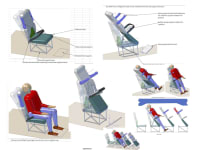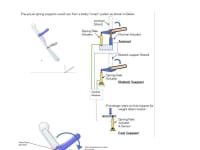Airliner Economy Class Sleeper Seat
Long nonstop airline flights of 10 to 20 hours are not uncommon. As anybody who has done it can confirm, making these flights in economy class can be very unpleasant as well as dangerous (Thrombosis). As the hours drag on it becomes harder and harder to find any position of comfort. Sleep for many people is impossible. This idea suggests a possible way to best utilize the existing very limited volume available to each economy passenger. It is primarily aimed at providing a sleeping platform but also allows an escape from a fixed sitting position. For most passengers, the only change available during flight is tilting the seat back (and taking volume away from the passenger behind them). This is a proposal that would utilize this very limited available envelope.
About the only way to utilize this envelope is a semi standing position and may require local revision to overhead bin. Among the many attempts to cram more and more people into a single flight an approximation of this position has been considered. It appears the passenger would be carrying their full weight on their feet and if acceptable at all would be for short flights and hardly suitable to sleeping.
What is proposed is a seat design using existing technology that can take advantage of that existing envelope. With normal in bed sleep when a person is sleeping on their back the body is mostly at four areas, the head, shoulders, buttocks & feet. Measuring a 197 pound male gave the following approximate percentage at each of these areas: Head 6.1%, Shoulders 25.4%, Buttocks 21.8%, Feet 9.1 %. Or 62.4% of total with the rest distributed. This proposal will attempt to use these same major support areas (except head support load would be redistributed to the other three supports) and these three supports would carry 100% of load. See Attachment 1.
The proposed seat would be used in the same way as existing seats and meet the requirements of FAR 25 but during flight may be unfolded to provide a semi- vertical support at the two arm pits, buttocks and feet approximating normal bed support as much as possible.
The direction of support is of course rotated 70-80 degrees. See Attachment 2
In the sleep position, the supports would provide the proper position and spring rates to give desired support values. The actual spring supports could vary from a totally "smart" system to the other extreme which would be a simple no frills system where the floor is the foot rest, the buttock support merely rotates into position with no variable spring support, and the armrest has a simple fixed spring rate. The complexity of the design would have to be determined by an organization capable of extensive human factors study as well as production and certification abilities meeting FAR 25 certification requirements. See Attachment 3
Like this entry?
-
About the Entrant
- Name:Donald Lefever
- Type of entry:individual
- Software used for this entry:Geomagic Design Excel
- Patent status:none








